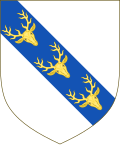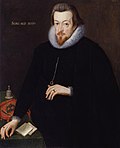Top Qs
Timeline
Chat
Perspective
List of Manx monarchs
From Wikipedia, the free encyclopedia
Remove ads
This article lists the monarchs who have ruled the Isle of Man. The island has been ruled by Brythonic, Irish, Scottish, Hiberno-Norse, English, and British monarchs. Currently, the island is ruled by the Lord of Mann, Charles III, who is represented by Lieutenant Governor, Sir John Lorimer.
This article has an unclear citation style. (July 2025) |
- Top left: Manannán mac Lir is the mythological first ruler of Mann.
- Top right: Merfyn Frych was the last Brythonic King of Ynys Manau.
- Bottom left: William I of Mann was the first independent English King of Mann
- Bottom right: Charles III is the current Lord of Mann.
Remove ads
Mythology
According to Manx mythology, the first ruler of the Isle of Man was Manannán mac Lir.[1]
Kings of Galwyddel (c.400 ‒ c.550)
The Kingdom of Galwyddel was a Brythonic kingdom, part of the Hen Ogledd, in modern-day Galloway, Scotland. The Kingdom was likely a breakaway polity from the Kingdom of Alt Clut led by Tutgual of Galwyddel, son of King Cinuit of Alt Clut and is believed to have maintained authority over the Isle of Man.[2] Around 550, Galwyddel was invaded and annexed by the Kingdom of Rheged, under King Urien. The Galwyddel King, Senyllt, was forced to flee to Ynys Manau (Isle of Man).[3]
Remove ads
Kings of Ynys Manau (c.550 ‒ 578)
Following his expulsion from Galwyddel, Senyllt continued to rule over the Isle of Man as the independent King of Ynys Manau.[3]
Ulaid rule (578 ‒ 582)
The Annals of Ulster record an expedition of the Ulaid to the Isle of Man in 577 and their return in 578 in which King Báetán mac Cairill imposed his authority on the island.[5] In 582 after his death, the annals record the taking of Man by Áedán mac Gabráin.[6]
Remove ads
Dál Riada rule (582 ‒ c.600)
In 582, Dál Riada are recorded taking the island under King Áedán mac Gabráin. According to some sources he established a puppet king, Diwg.[7]
Kings of Ynys Manau (c.600 ‒ 620)
Bernician-Deiran rule (620 – 633)
Kings of Ynys Manau (633 ‒ 825)
Remove ads
Gwynedd rule (825 ‒ 836)
In 825, Merfyn Frych becomes King of Gwynedd bringing Mann under Welsh rule.
Early Norse rule (836 ‒ 914)
In the 800s, Mann came under the rule of a series of primarily Hiberno-Norse kings and incorporated into the Kingdom of the Isles. Various rulers have been identified as ruling Man, but not the Kingdom of the Isles as a whole. The Isle of Man may have fallen under Norse rule in the 870s, and paradoxically they may have brought the Gaelic language with them. The island has produced a more densely distributed Viking Age archaeology than anywhere else in the British Isles, but the written records for this time period are poor.[15][16]
Remove ads
Kingdom of the Isles (914 ‒ 1265)
Summarize
Perspective
Since the emergence of Somerled and his descendants in the 12th century, the Manx kings began to lose territory and power in the Hebrides. Before the reigns of the three sons of Olaf the Black, the Manx kings styled themselves "King of the Isles". By the time of the reigns of Olaf's sons, the kings had begun to style themselves "King of Mann and the Isles".
Remove ads
Scottish and English rule (1265 – 1333)
Summarize
Perspective
Between 1265 and 1333, Mann was ruled directly by the Kings of Scotland (1265–1290, 1293–1296, 1313–1317, 1328–1333) or the Kings of England (1290–1293, 1296–1313,[63] 1317–1328).
Kings of Mann (1333 ‒ 1399)
English suzerainty (1399 ‒ 1504)
Lords of Mann (1521 ‒ present)
Summarize
Perspective
Edward Stanley, 3rd Earl of Derby, the son of Thomas Stanley, 2nd Earl of Derby, did not take the style "King", and he and his successors were generally known instead as Lord of Mann.[70][71] However, the Latin style Rex Manniae et Insularum (King of Mann and the Isles) continued to be occasionally used in official documents until at least the 17th century.
In 1765, the title was revested in the Crown of Great Britain; thus today the title, Lord of Mann, is used by King Charles III.[72][73] Queen Victoria was styled as Lady of Mann, whereas, title "Lord" was used by Queen Elizabeth II.[74]
Succession dispute (1594–1607)
After Ferdinando's death, the succession is disputed between his daughters and his brother William, Earl of Derby. Ultimately the English Privy Council awarded the island to the daughters of Ferdinando.[75] However, they were all below the age of majority at the time so James I of England appointed two successive interim Lords of Mann to act as regents.[76]
In 1609, the Parliament of England passed the Assurance of the Isle of Man Act 1609 (7 Jas. 1. c. 4 Pr.)[77] which established the title in law as Lord of Mann. The lordship was conferred by letters patent dated 7 July 1609 upon William Stanely, Earl of Derby.[78]
See also
References
Wikiwand - on
Seamless Wikipedia browsing. On steroids.
Remove ads























